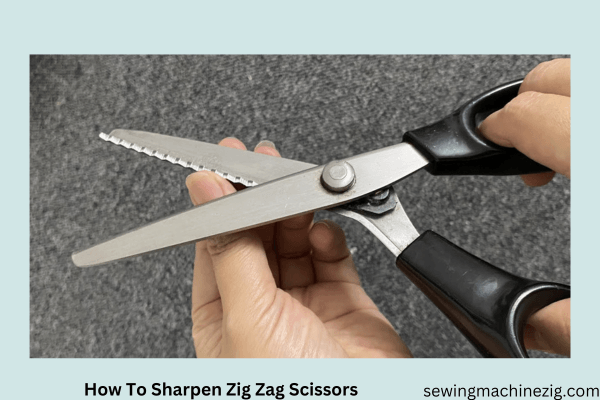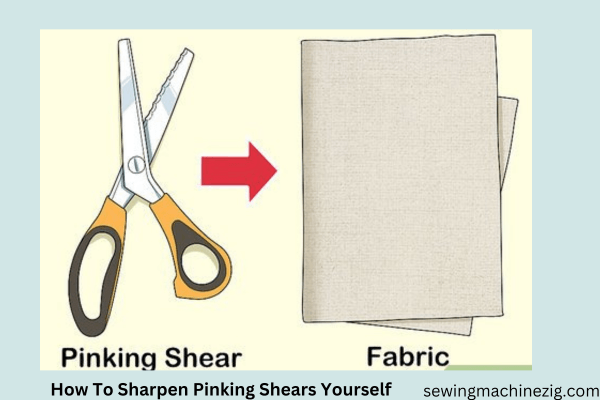
Knowing how to sharpen pinking shears yourself can be a valuable skill for anyone who regularly works with fabric. Pinking shears, with their zigzag-shaped blades, are designed to prevent fabric fraying and create decorative edges.
Thank you for reading this post, don't forget to subscribe!However, constant use can cause the blades to become dull over time, affecting their cutting efficiency. Rather than replacing your pinking shears or seeking professional sharpening services, learning to sharpen them yourself can save you time and money.
Sharpening pinking shears yourself requires a few essential tools and proper techniques to ensure the best results for understanding how to sharpen pinking shears yourself. It is crucial to identify whether your pinking shears are suitable for sharpening at home, as some models have blades that are permanently fixed. Once confirmed, you can proceed with the sharpening process, rejuvenating your pinking shears and restoring their cutting edge.
In this article, we will provide you with a step-by-step guide on how to sharpen pinking shears yourself. We will discuss the necessary tools, share detailed instructions, and provide helpful tips to ensure a successful sharpening experience.
By mastering this skill, you can maintain the functionality and longevity of your pinking shears, allowing you to continue enjoying their benefits for many sewing projects to come.
Materials:
- Pinking shears
- Fine-grit sandpaper or emery cloth
- Honing oil or sewing machine oil
- A soft cloth or paper towel
- Screwdriver (if applicable, for disassembling the shears)
- Ruler or measuring tape
How To Sharpen Pinking Shears Yourself Step-By-Step Guide:

Step 1: Gather all the necessary materials mentioned above, ensuring that you have everything within reach before starting the sharpening process.
Step 2: Find a suitable workspace that provides ample lighting and a clean, flat surface for sharpening your pinking shears. Place a soft cloth or paper towel on the surface to prevent any scratches or damage to the shears.
Step 3: If your pinking shears are designed to be disassembled, use a screwdriver to carefully remove any screws holding the blades together. Take note of the parts and store them safely in a designated container during the sharpening process.
Example: For a 9-inch pinking shear, leave approximately 1 inch of space on each side, ensuring that the total length of the blade is 7 inches.
Step 4: Clean the blades using a soft cloth or paper towel to remove any dirt or debris. Ensure that the blades are completely dry before proceeding to the next step.
Example: Leave about 1/4 inch of the sandpaper extending beyond the cutting edge on both the left and right sides.
Step 5: Using gentle and even pressure, move the sandpaper back and forth along the blade, following the contour of the teeth. Repeat this motion several times, gradually moving from the base to the tip of the blade.
Example: Leave approximately 1/8 inch of the cutting edge untouched on each side to maintain the integrity of the blade.
Step 6: Repeat the sharpening process on the other blade of the pinking shears, ensuring that both blades receive an equal amount of attention and sharpening.
Example: After sharpening, there should be no more than 1/8 inch of material left on each side of the blades.
Step 7: Once both blades are sharpened, wipe away any residual oil or debris using a soft cloth or paper towel. Reassemble the pinking shears if they were disassembled, ensuring that all parts are securely tightened.
Example: Store the newly sharpened pinking shears in a protective case or sheath to prevent damage to the blades and maintain their sharpness for future use.
Remember:
The specific measurements and tolerances may vary based on the size and manufacturer of your pinking shears. Hope now you learn very well how to sharpen pinking shears yourself. It’s always recommended to refer to the manufacturer’s instructions or consult a professional if you have any doubts or concerns during the sharpening process.
How To Sharpen Zig Zag Scissors
Zigzag scissors, also known as pinking shears, are a valuable tool for seamstresses, crafters, and fabric enthusiasts. These specialized scissors feature zigzag-shaped blades that create a decorative edge on the fabric while preventing fraying and sharpening a zig-zag scissor by yourself is also a bit different than how to sharpen pinking shears yourself. However, like any cutting tool, zigzag scissors can lose their sharpness over time due to regular use.
Sharpening zigzag scissors is an essential skill that allows you to maintain their cutting efficiency and prolong their lifespan.
In this article, we will guide you through the process of sharpening zigzag scissors, providing you with the knowledge and techniques to restore their sharpness and ensure precise and clean cuts for your sewing and crafting projects.
Here’s a detailed guide on how to sharpen zigzag scissors, including the required materials, step-by-step instructions, and examples explaining the measurements:
Materials:
- Zigzag scissors (pinking shears)
- Fine-grit sandpaper or emery cloth
- Honing oil or sewing machine oil
- Soft cloth or paper towel
- Screwdriver (if applicable, for disassembling the scissors)
- Ruler or measuring tape
Step-By-Step Guide:
Step 1: Gather all the necessary materials mentioned above, ensuring you have everything within reach before starting the sharpening process.
Step 2: Find a suitable workspace with ample lighting and a clean, flat surface to sharpen your zigzag scissors. Place a soft cloth or paper towel on the surface to protect the blades and prevent any scratches.
Step 3: If your zigzag scissors can be disassembled, use a screwdriver to carefully remove any screws holding the blades together. Take note of the parts and store them safely in a designated container during the sharpening process.
Example: For a 7-inch zigzag scissor, leave approximately 1 inch of space on each side, ensuring that the total length of the blade is 5 inches.
Step 4: Clean the blades using a soft cloth or paper towel to remove any dirt or debris. Ensure that the blades are completely dry before proceeding to the next step.
Example: Leave about 1/4 inch of the sandpaper extending beyond the cutting edge on both the left and right sides.
Step 5: Using gentle and even pressure, move the sandpaper back and forth along the blade, following the contour of the zigzag teeth. Repeat this motion several times, gradually moving from the base to the tip of the blade.
Example: Leave approximately 1/8 inch of the cutting edge untouched on each side to maintain the integrity of the blade.
Step 6: Repeat the sharpening process on the other blade of the zigzag scissors, ensuring that both blades receive equal attention and sharpening.
Example: After sharpening, there should be no more than 1/8 inch of material left on each side of the blades.
Step 7: Once both blades are sharpened, wipe away any residual oil or debris using a soft cloth or paper towel. Reassemble the zigzag scissors if they were disassembled, ensuring all parts are securely tightened.
Example: Store the newly sharpened zigzag scissors in a protective case or sheath to prevent damage to the blades and maintain their sharpness for future use.
Remember:
The specific measurements and tolerances may vary based on the size and manufacturer of your zigzag scissors. It’s always recommended to refer to the manufacturer’s instructions or consult a professional if you have any doubts or concerns during the sharpening process.
Conclusion:
Learning how to sharpen pinking shears yourself is a valuable skill for any sewing enthusiast or crafter. By following the step-by-step process outlined in this guide, you can restore the sharpness and cutting efficiency of your pinking shears.
Sharpening your pinking shears allows you to maintain clean, precise, and decorative fabric edges while preventing fraying. With the right materials and techniques, you can prolong the lifespan of your pinking shears and save money by avoiding professional sharpening services.
Remember how to sharpen pinking shears yourself need to exercise caution during the sharpening process and refer to the manufacturer’s guidelines for specific instructions. With properly sharpened pinking shears, you’ll be able to embark on your sewing projects with confidence and achieve professional-quality results.
FAQs:
Q 1: How Do I Know When My Pinking Shears Need Sharpening?
A: You can tell that your pinking shears need sharpening when they start to snag or tear the fabric instead of creating clean, crisp zigzag edges. Dull blades may also result in uneven or frayed cuts.
Q 2: Can I Sharpen Pinking Shears With A Regular Knife Sharpener?
A: It is not recommended to use a regular knife sharpener for pinking shears. Pinking shears have specialized teeth that require a different sharpening technique. Using a proper method, such as using sandpaper or emery cloth, ensures optimal sharpening results.
Q 3: Should I Disassemble My Pinking Shears Before Sharpening?
A: Not all pinking shears can be disassembled. If your shears are designed to be disassembled, it can provide better access for sharpening. However, if they are permanently fixed, you can still sharpen them effectively without disassembling them.
Q 4: Can I Use A Sharpening Stone To Sharpen Pinking Shears?
A: While sharpening stones are suitable for some blades, they are not recommended for pinking shears. The zigzag pattern requires a specific sharpening technique using fine-grit sandpaper or emery cloth to maintain the integrity of the teeth.
Q 5: How Many Times Should I Repeat The Sharpening Process?
A: The number of repetitions depends on the condition of your pinking shears. It is recommended to repeat the sharpening process until you achieve the desired sharpness and cutting performance. Regularly test the shears on fabric scraps to evaluate their effectiveness.
Q 6: Should I Apply Oil To The Pinking Shears After Sharpening?
A: Yes, applying a small amount of honing oil or sewing machine oil to the blades after sharpening helps lubricate and protect them from rust. Wipe off any excess oil before using the shears to prevent oil stains on the fabric.
Q 7: How Often Should I Sharpen My Pinking Shears?
A: The importance of “How To Sharpen Pinking Shears Yourself” frequency of sharpening depends on how frequently you use your pinking shears and the type of fabric you cut. As a general guideline, you may need to sharpen them every 6 to 12 months or when you notice a decline in cutting performance.



